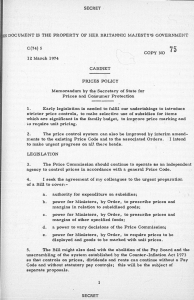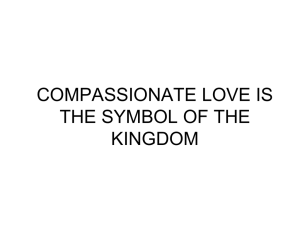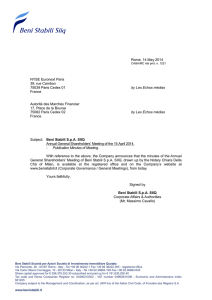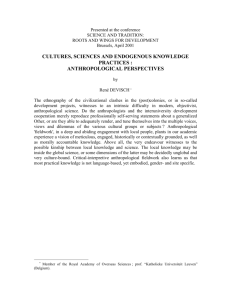Time and Space in Kadare “Winter of the Great Loneliness”
advertisement
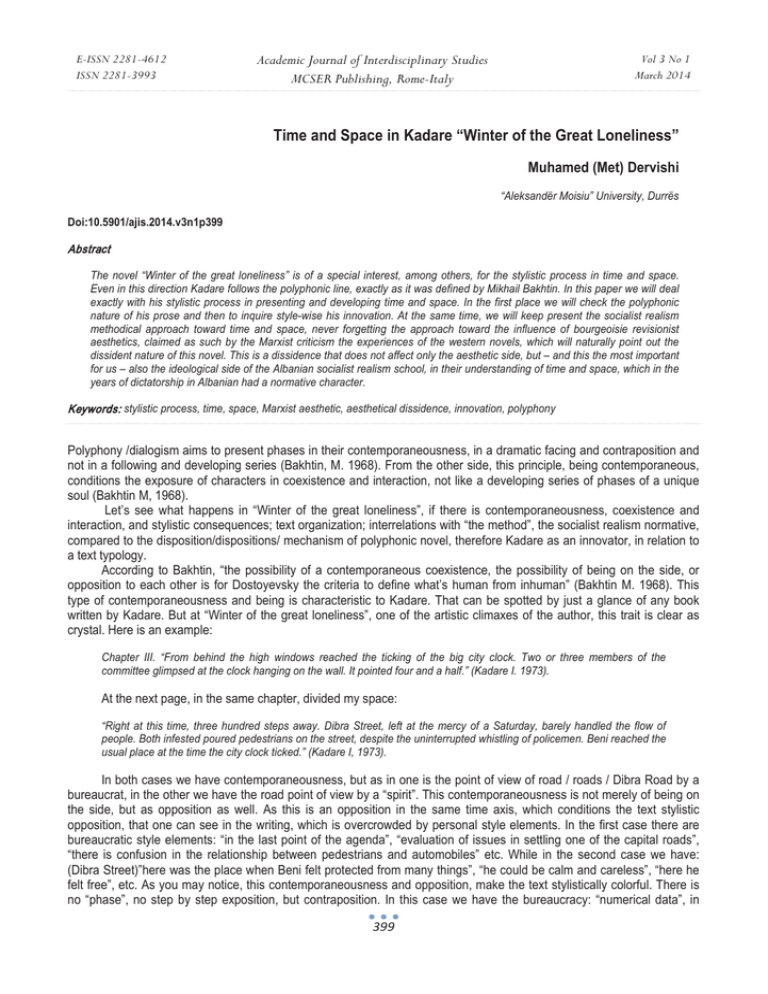
E-ISSN 2281-4612 ISSN 2281-3993 Academic Journal of Interdisciplinary Studies MCSER Publishing, Rome-Italy Vol 3 No 1 March 2014 Time and Space in Kadare “Winter of the Great Loneliness” Muhamed (Met) Dervishi “Aleksandër Moisiu” University, Durrës Doi:10.5901/ajis.2014.v3n1p399 Abstract The novel “Winter of the great loneliness” is of a special interest, among others, for the stylistic process in time and space. Even in this direction Kadare follows the polyphonic line, exactly as it was defined by Mikhail Bakhtin. In this paper we will deal exactly with his stylistic process in presenting and developing time and space. In the first place we will check the polyphonic nature of his prose and then to inquire style-wise his innovation. At the same time, we will keep present the socialist realism methodical approach toward time and space, never forgetting the approach toward the influence of bourgeoisie revisionist aesthetics, claimed as such by the Marxist criticism the experiences of the western novels, which will naturally point out the dissident nature of this novel. This is a dissidence that does not affect only the aesthetic side, but – and this the most important for us – also the ideological side of the Albanian socialist realism school, in their understanding of time and space, which in the years of dictatorship in Albanian had a normative character. Keywords: stylistic process, time, space, Marxist aesthetic, aesthetical dissidence, innovation, polyphony Polyphony /dialogism aims to present phases in their contemporaneousness, in a dramatic facing and contraposition and not in a following and developing series (Bakhtin, M. 1968). From the other side, this principle, being contemporaneous, conditions the exposure of characters in coexistence and interaction, not like a developing series of phases of a unique soul (Bakhtin M, 1968). Let’s see what happens in “Winter of the great loneliness”, if there is contemporaneousness, coexistence and interaction, and stylistic consequences; text organization; interrelations with “the method”, the socialist realism normative, compared to the disposition/dispositions/ mechanism of polyphonic novel, therefore Kadare as an innovator, in relation to a text typology. According to Bakhtin, “the possibility of a contemporaneous coexistence, the possibility of being on the side, or opposition to each other is for Dostoyevsky the criteria to define what’s human from inhuman” (Bakhtin M. 1968). This type of contemporaneousness and being is characteristic to Kadare. That can be spotted by just a glance of any book written by Kadare. But at “Winter of the great loneliness”, one of the artistic climaxes of the author, this trait is clear as crystal. Here is an example: Chapter III. “From behind the high windows reached the ticking of the big city clock. Two or three members of the committee glimpsed at the clock hanging on the wall. It pointed four and a half.” (Kadare I. 1973). At the next page, in the same chapter, divided my space: “Right at this time, three hundred steps away. Dibra Street, left at the mercy of a Saturday, barely handled the flow of people. Both infested poured pedestrians on the street, despite the uninterrupted whistling of policemen. Beni reached the usual place at the time the city clock ticked.” (Kadare I, 1973). In both cases we have contemporaneousness, but as in one is the point of view of road / roads / Dibra Road by a bureaucrat, in the other we have the road point of view by a “spirit”. This contemporaneousness is not merely of being on the side, but as opposition as well. As this is an opposition in the same time axis, which conditions the text stylistic opposition, that one can see in the writing, which is overcrowded by personal style elements. In the first case there are bureaucratic style elements: “in the last point of the agenda”, “evaluation of issues in settling one of the capital roads”, “there is confusion in the relationship between pedestrians and automobiles” etc. While in the second case we have: (Dibra Street)”here was the place when Beni felt protected from many things”, “he could be calm and careless”, “here he felt free”, etc. As you may notice, this contemporaneousness and opposition, make the text stylistically colorful. There is no “phase”, no step by step exposition, but contraposition. In this case we have the bureaucracy: “numerical data”, in 399 E-ISSN 2281-4612 ISSN 2281-3993 Academic Journal of Interdisciplinary Studies MCSER Publishing, Rome-Italy Vol 3 No 1 March 2014 opposition to human: “soul”. There is no comment made by the author, no psychological penetrations, but an “an individualized language” in the monologic text approach. Here we can find an essential difference between Kadare and Dostoyevsky prose. According to Bakhtin, in Dostoyevsky we see political and religious eschatology, in his tendency to approach “the end”, the tendency to see it in present time (Bakhtin M, 1968). Therefore in Dostoyevsky we have an ethic-moral and religious side, while in Kadare, as appointed by the examples (a topic to be further developed) we have an opposition in an anthropological connotation “man/bureaucrat – “numerical data/soul “. Below, what follows in the same chapter, now at six o’clock: Space again, after the opposition Beni/bureaucrats yet again in contemporaneousness: “At this time the “Interflug” plane, that followed the usual itinerary Berlin-Budapest-Tirana, was somewhere out of Hungary, headed toward southeast of the continent. The reporter of AFP( Frencj Agency of Press), with the whole body inclined, was looking down from the circle shaped window...” (Kadare I, 1973). Further, still in the same chapter, but after space: “The Hungarian airplane”, said Sala keeping the head up, toward that corner of the sky where showed the red and blue signals of a passengers aircraft.“ (Kadare I., 1973). Here we find the same as above: same axis of contemporaneousness, which unifies creatures, characters, which by no means can get in touch with each other, but same as the case of bureaucrat/Beni interact with each other. Interaction of such nature is impossible to be in the nature of monologic novel, characterized by the epic exposure in following phases or as a chain reaction, connected to character psychology, environment, habitat, evolution etc. In Beni /bureaucrat case we had the opposition numerical data/soul /. Let’s see now the nature of this other contemporaneous interaction. Here what we have in the AFP reporter, sitting in the same plane seen by Beni, therefore contemporaneously with him, on the same page. Being on the plane, the reporter sees the world from above: “Here, the socialist camp”, saying it over with himself, (style elements with political semantics); “The most serious part of the world. These plains... (style elements with political connotation); “the first trip in the communist world” (political); “this communist world, he thought” etc. And this is what goes on among Beni and broadwayers, who for a little while were disputing on plane timetables (It is the same plane of the AFP reporter): “Not a peep was heard out of Beni. To hell. He couldn’t think of anything else but that disheveled day named Saturday”. Here we have contemporaneousness and a “hidden” replica made in distance. The replica, that sounds absurd, is a result, of the coming to one side of the characters in contemporaneousness, which have no contact with each other, except time. But placement in the same time level produces the “replica”, which is imperceptible otherwise. Ben’s “replica” is connected to plane timetables being in relation with, through the associations of AFP reporter on communist world. In the hidden “replica” of Ben, other than plane timetables we notice: “…with aircraft companies and their timetables, to hell even with the sky”. Here we have a dialogism/polyphony case, typical of Kadare. This is an element, which from one side tints the text with style elements, and on the other produces the oneiric character of his prose (Oneiric contemporaneousness characteristic to dreams). If in the first case we had the opposition anthropological bureaucrat/ numerical data- soul, now we face politics/Eros: “communist worlds” (AFP reporter)/ disheveled day named Saturday (Beni, Monda). Out of this/these oppositions in contemporaneousness clusters: “communist world” etc. and “disheveled day named Saturday” etc. would ne neutral from the stylistic charge approach. Here another example of the “replica in distance”, still in contemporaneousness: Chapter I: Zana walks Besnik, kisses him in the neck, etc. They part: She disheveled his hair. “Good night, than”. “Good night.” (Kadare I, 1973). Space again, still in contemporaneousness, but now with the old woman Nurihan. Here is her replica in the distance: “They part on stairways, they kiss, say goodnight”, whispered with herself the old woman Nurihan, pouring the chamomile in the glass. “Blackened night. Why cannot I fall asleep … (Kadare I, 1973). Yet again contemporaneousness, characters living in the same moment, but through different perspectives. Exactly this being on the side/ opposition produces replica in distance. This technique turns greetings like “Good night” in style elements with ideological. Here we have two different worlds, not only politically (They up there/ old woman Nurihan downstairs, but as well the old woman/ two young people). Exactly this being on the side/ opposition on the same moment creates the conditions for the antithesis: “Blackened night”, which sound like an anti-greeting, but actually it is a 400 E-ISSN 2281-4612 ISSN 2281-3993 Academic Journal of Interdisciplinary Studies MCSER Publishing, Rome-Italy Vol 3 No 1 March 2014 curse. And, like in the sequences above, we still have the same aim in the meanings of anthropological codes. In this case: class differences – the class above / the class below; youth/senility; Greetings, Eros, happiness /curse that live side by side and tint the text in emotions and oneiric. 1. Symbolic Code. Anthropological Versus Ethic and Moral. Anthropological Versus Classes, MarxismLeninism Contemporaneousness in Kadare foretells being on one side or opposition, under the world supremacy and point of view of the character/ characters. As we have mentioned earlier, the author in Kadare is withdrawn and you can find him only in the creative scheme. Opposition in contemporaneousness level produces an intensive dialogism, full of contrasts and dramatically charged. Above we saw that differently from Dostoyevsky eschatology, Kadare text aims the anthropological order. The connection to anthropological order gives a symbolic character to Kadare text. His intertextuality brings to classifications such as: bureaucratic/ human, youth/ senility etc. (Other works will point out topics such as differences in Kadare and Joyce dialogism etc.). Let’s check in the first place if such alternation is characteristic to text and in second place, if so, to which anthropological codes do they correspond. For this we have to turn back to the character/ characters. According to Bakhtin, in Dostoyevsky heroes do not have biography in the meaning of past and fully lived experience. His heroes remind from past only what for them have never stopped of being such even in the present: a sin, a crime, and an offence never forgiven (Bakhtin 1968). In the meanwhile we have already said that in Kadare characters usually return to an old obsession, for which it never stopped being experienced as present. It is exactly the semantic of these obsessions bringing us to classifications of anthropological order, therefore in the symbolic codes suggested in the “Winter of the great loneliness”. Before we jump at the character’s obsessions/obsessions nature, let’s focus to the text surface (S) in “reality”. For that let’s follow chapter XVIII, an inquiry we can make to any chapter. Besnik is in the printing house. Vice editor in chief called. They needed to make space for a text of forty lines in the first page. For the newspaper: “The page designer had already made place in the first page. The emptiness of a dark square in the lead started to torment Besnik. “What could it be?” thought for the tenth time. “The second group of four hundred students returned yesterday from Soviet Union and Czechoslovakia? How was that possible? There was no news for the first group.”(Kadare I. 1973). Some paragraphs above we had “an empty space on the first page”, where “an empty space” is the semantic core, which in this paragraph, turns into “the emptiness of a dark square”, emptiness, which has been named (emptiness). And then we have “dark”, which does not come from the semantics of “space”, but from “emptiness”. Exactly this shift of the semantic center suggests other codes (shift from the object to the feature). Check what happens below, advancing two paragraphs: “When he returned in the page designing room, the empty space in first page looked like a hole by landslip. He had encountered such holes in the winter plateaus, when he was on field trip. With black water in their bottom.” (Kadare I. 1973). Now the word group “empty space” becomes “a hole”. Then “landslip” suggests a war code (bombing). In reality there is only “the empty space in first page”, which in the first place turned into “the emptiness of a dark square”, second into “a hole”, which associates with “landslip”, a characteristic word in Albanian perception of bombardments. In the meanwhile, in the last sentence of the paragraph, what until now was suggested (War), is given like reality: “holes”, that are taken for granted, as they are part of Besnik psyche, “black water in their bottom”. “Black water” clearly suggests war/ death: “the hole” (after bombardments). At the moment we are still in the psychological associations of Besnik, but here what happens further, a couple of paragraphs later: comes the news that there was a flood. And with that even the article for the “empty space” which is not forty lines, but seventy: “Besnik and Ilir kept looking at the page designer leaning on the emptiness of page one. That hole was enlarging.” (Kadare I. 1973). 401 E-ISSN 2281-4612 ISSN 2281-3993 Academic Journal of Interdisciplinary Studies MCSER Publishing, Rome-Italy Vol 3 No 1 March 2014 As you can notice, psychological associations of Besnik turn into physical perceptible reality. But this comes only in the end of this theme. In “hole was enlarging” we don’t have an “author”, neither the style element of “looked like” etc. of this nature, but something percept as a physical fact. In the meanwhile let’s see codes alternation in the same chapter. Besnik is in the bar. Drinking “for no reason”. “Just to respect the bar entity”. “But it wasn’t just that. Since the quarrel with Zana, he felt a new relationship between him and all bars of Tirana. More than an inner need going to bars was a certain duty, a certain respect toward tradition. All people with a complication in life create a certain relationship with bars” (Kadare I. 1973). If a while ago, war/death were suggested, not it alternates with Eros: “Zana” his life complication”. It is notable that in Kadare text the psychological fact tents the anthropological. It is exactly this tendency that conditions the paragraphs’ structures and not vice versa, psychological analysis, which is characteristic to monologic text. And here is how Eros comes out again, still in the alternation with flood/ hole/ war/ death: Besnik is in the same car with Mira, his sister. She goes out of the car. “Besnik followed her with the eyes for some instants, as she crossed the road with her girlish walk: the bag in her hand, trousers and all of this gave Besnik a tamed version of pain, because of the fact that she was becoming foreign and this was inevitable, and it couldn’t be different, it shouldn’t be different. She is certainly making love; he thought for a second and wiped her off his thoughts right away” (Kadare I. 1973). Alternations of this nature are characteristic to Kadare. These alternations produce contrasts and tint the text with emotions. These contrasts create as well is “figurative” speech and not vice versa. So, we are dealing with a view on the world which inducts stylistic solutions and not vice versa. Only in this article we have the following alternations: flood pg. 326/ war pg. 327/ corpse pg. 328/ Eros pg. 331/ class conflict pg. 334/ flood – class overturn – Zana – Mark / class conflict, curse of expropriates, - old woman Nurihan pg. 337/ death, landslip pg. 337/ Headquarters against flood No. 4 pg. 337/ revolutionary mobilization (war) pg. 341/ Eros pg. 342/ war, “earth disappears, said a villager” pg. 433/ Eros of war, the idiot pg. 345/ Eros, Zana, but always alternated with war/ death “the wires pass above the winter plateaus, above death”, pg. 348 and the end of the chapter. As it is notable, there are code alternations. Ideological as a code comes first under layered below the big codes of war/ Eros, in opposition to life and death; second this suggestion toward higher codes overpasses the ideological code which was the highest level of perception in socialist realism normative. In this case, the creative scheme goes against the ideological socialist realism scheme. Even when it embraces “the class conflict”, it embraces both sides, both camps, as it obeys to the creative scheme of Kadare, that raises above and beyond the ideological code of socialist realism. 2. Symbolic Code. Obsessions As we said, Kadare characters, in their intersubjectivity and in the interindividual as well, step by step, “sink” in a personal obsession. Let’s check the relationships between these obsessions and symbolic / anthropological codes. On this purpose we are following obsessions that are noticed in the first chapter. We should keep present that these obsessions, characteristic to one character or another, keep coming out throughout the whole text, from start until to the end. And they keep getting new meanings, related to a specific code. From the other side, all these obsessions are always associated with an external simulative factor. This is quite obvious since the first obsession we encounter in Besnik: snakes. In this case the external simulative factor is the snake symbol at the drugstore, where Besnik entered with a prescription for his father medicines. Let’s follow step by step the obsession of snake/ snakes to see in the first place Kadare characteristics, second the way he gives new meanings to these obsessions heading toward other codes. Snake obsession comes in pg. 9: “Here, the snake”, he said to himself. His eyes had encountered the drugstore symbol… Who the hell invented this disgusting symbol? For sure some sociopath. I am scared of snakes, too, but your repulsion for them astonishes me, Zana told him once… etc. (Kadare I. 1973). In the above sequence we are in the psychological code: repulsion. A bit later, in the same paragraph, Besnik reminds the times he was on field trip in Butrint. Here we have: “Silence was extraordinary. The walls of the ancient city, columns, statues and the amphitheater, where they use to enact Greek tragedies… Oedipus King. Electra.” (Kadare I. 1973) 402 E-ISSN 2281-4612 ISSN 2281-3993 Academic Journal of Interdisciplinary Studies MCSER Publishing, Rome-Italy Vol 3 No 1 March 2014 As you can note, now we have a passage to other codes: ancient tragedies, Oedipus, Electra; anthropologically tragic/ war. And a bit further: “Zef pointed with his hand: the orator. The philosopher. The other orator. There, do you see that bunch of statues? …They represent an ancient chorus. The day before yesterday snakes were hanging on their shoulders.” (Kadare I, 1973). Here we go again with the tragic code. But enters even the ancient chorus / still in a war code, but now in front of the people/ chorus. In reality we are following Besnik in a field trip, but tragic, war, spectators, snakes in the amphitheater bleachers are suggested. Like this the message that escaped the starting psychological code gets intensified. In Kadare prose he is always associating with other codes. This is another strong spot in Kadare dialogism: if in a monologic text we would have had a character with an ophidiophobia, there would have been digressions on its causes, childhood, etc. In Kadare prose there are not such things, everything is subdued to contemporaneousness, and everything happens in the present. For Besnik fear, for its psychological and genetic aspect the author brings some info, but not from the author himself, but from another conscience. Here is what we have, for example on pg. 64: Now we are with the aunt, Rabo, in her intersubjectivity. Rabo is in the cave with the kids: “But something shuffled deep in the cave. The snake, said Besnik. Don’t be afraid, there are no snakes in the winter. She heard the shuffling once more and put the hands on the girl cradle” (Kadare I. 1973). So, genesis generates in anther comes from another conscience, in contemporaneousness with present: Rabo is nearby the refrigerator in her house, but in her intersubjectivity she lives with war, so we are still in the war code. In the meanwhile we said that obsession/ obsessions are taken over and over again in the text, and refreshed with new meanings. Here an example, in Georgievskija Hall, in Moscow: “Khrushchev head moved threateningly. The audience rose. They were attacked simultaneously. Order was placed again. Dramatic clamors reached from the stand. Besnik felt sick, like that day in Butrint, when he saw the snakes hanging from the statues shoulders” ( Kadare I. 1973). Let’s follow now obsessions of Chapter I and their accordingly codes. To be noted is the fact that they are different characters, in different paragraphs, dominated by the same obsession: matter of climate pg. 14; Kristaq “matter of climate”; relationships with Soviet Union, political code; pg. 17, Besnik in intersubjectivity: “It is absolutely a matter of climate, he thought…; political code. Or another obsession, pg. 20, old woman Nurihan in intersubjectivity: “We hunt around like shadows and we do not talk. This house looks already like ruins. From where did arouse this crazy wind that turned as all over… The dead would truly rule the world…”; Death / communism. Let’s continue further, in pg. 32 the old photographer Xan. “Enver has a big issue”… She could turn astonished her wrinkled face and tell him: “God, hope there is no war exploding”; like that is always aimed another code, in this case “war”. Pg. 37, Beni in intersubjectivity: “He would have won the contest this year, if he didn’t follow the advice of a stupid girl, to compete with the soliloquy of crazy Ophelia”; Eros. Pg. 42, AFP reporter on the airplane: “In this vast and monotonous area, he should find in which region, in which unknown realms was that crack, the little cleft, the wound that would bring Titanic to sinking”; communist camp disruption, political code; War “wound”. Pg. 45, Beni in intersubjectivity: “Something scratched his heart. Very soon edgy tools appeared. The ones drawing arrows and needles were right”; Eros. Pg. 49 AFP reporter already in Tirana, in intersubjectivity: “all in all a matter of climate”; political code. As you can note we have a kind of dialogism of the same obsession, a certain passage in time of the same pattern, from one person to the other, in different contexts, which refresh meanings. Pg. 53, the woman that stayed a bit apart, the partisan woman, in the reception for the embassies: “Sulo Gjoni bomb”; obsession in this case draws to war, but at the same time to class confliction between two camps. Pg. 54, AFP reporter, in intersubjectivity: “but probably is really a matter of climate”; so we have the same obsession like in the characters we saw above, with which he has no contact at all. Here, as we are dealing with a French reporter, intending west, we are at the political code, at the split of the socialist camp, so much desired by the French reporter, intending west. Let’s proceed further. Pg. 61, Aunt Rabo, in intersubjectivity: “And all of a sudden, in the napping, in the beginning far and then nearer and nearer, she heard the cry of the bitch wolf”; cave, bitch wolf / war. Pg. 68, the Doctor of the cobalt device, in intersubjectivity: “In the meanwhile, engineers were quickly making ready the lead clad room, the dwelling place where would enter, and never coke out again the long awaited, but deathly guest”/ technological code, death. Pg. 75, Raqi still in intersubjectivity: “He couldn’t understand how the fiancées or lovers, walking down the street, not sick at all or in life danger, walked arm in arm full of ecstasy. He would never forget Besnik such walk…” political code, anti403 E-ISSN 2281-4612 ISSN 2281-3993 Academic Journal of Interdisciplinary Studies MCSER Publishing, Rome-Italy Vol 3 No 1 March 2014 western/ anti-Eros in the bureaucratic party system, files, folders / antithesis of communist love, etc.; always Eros in its variations. Pg. 80, Xhemal Struga under the cobalt device, intersubjectivity: “Here, the “Shars” machine gun; technological code /war. Pg. 83, Beni, evenings, Saturdays, in his intersubjectivity: “Tha was enough to destroy an evening”; Eros as destruction. Pg. 92, Xhemal Struga, in intersubjectivity: “Anastas Lulo, you have betrayed The Internationale… partisan trial…”; communist purges, terror/ war. These are obsessions of Chapter I characters. As we noticed in what happens in S, therefore “in reality” codes alternate. But there are always two dominants: Eros/ life and war/death. These alternations follow the text until to the end and other than part of the creative scheme of Kadare, they are an indicator of his view on the world. Furthermore, this creative consciousness is shown at the end of the text. Here what Besnik says, still in intersubjectivity at the end of the novel, pg. 496: “He thought that in the moments when death shows the teeth, life should temporary pause. But it was not like that …” ( Kadare I. 1973). As for the relationships of the text with the socialist realism method, in Kadare prose, two codes get alternated: Eros and Thanatos in all possible variations, while the references of political codes come under layered. Other than a creative scheme, this is an outlook, but the normative of the socialist realism code was ideological/ political. According to this method ideological/ political were the “highest” code and the class conflict was considered as the engine of development/ social progress. While in Kadare the highest code/ codes are Eros and Thanatos and alternations in between. Such a creative scheme - and an outlook at the same time – went beyond method imagination/ imaginations. In the text written by Kadare is missing the ideologist author, furthermore, the communist ideological author. In Kadare scheme and outlook we find life and death, which brings to an anthropological concept, rather than ideological. This was one of the reasons, not to say “the one”, that the socialist realism code refused the book. But this as well shows that we are not dealing with merely an aesthetical dissidence. As we said, after “aesthetics” there is always a certain outlook/ world view. 3. Eternity in the Present According to Bakhtin, in the Menippean satire, but in Dostoyevsky as well, the action is collected in the fracture, crisis, and catastrophe in that very moment, when for its own intimate meaning, it is equal to “a billion years” (Bakhtin M. 1968). According to this Dostoyevsky conception, “in eternity everything is contemporaneous and everything coexists” “in a unique unit of time” (Bakhtin M. 1968). What makes in a polyphonic novel “the levels, despite different hierarchic highlighting, to lay side by side in the novel structure In coexistence (like Dante’s worlds) and interaction (what does not exist in Dante’s formal polyphony) and not to follow one-another, like development phases” (Bakhtin M. 1968). Let’s see now what happens with Kadare in the “Winter of the great loneliness”. Chapter 17, pg. 109, Besnik is in a villa by the Red Square in Moscow. Jordan tells him about the hidden truth on Genghis Khan. He died somewhere in China frontiers. The news should be kept secret. In order for no one to know, the guards of the emperor body kill anyone on their way. Still the news spread. Of course it refers to Moscow “splitting”. Here’s what we find on pg. 114: “Besnik thought that he had probably done wrong by mentioning Bucharest, but composed very soon oneself. He recalled the thousand guards accompanying the Genghis Khan dead body” (Kadare I 1973). This is a case of eternity in the present, but as well one of the tools used by Kadare, a very simple one, an association (Genghis Khan dead body/ the splitting corpse held by them) that coexist and interact in the right moment. In Kadare, this moment where eternity lives, reaches certain embodiments, that come to produce even cosmic time of… hell. Let’s see just one example: Moscow meeting. “The audience applauded again (real time, the moment). In Enver Hoxha eyes now there was an anger look. Besnik started to automatically translate again words and whole phrases. His brain was like in fever… (real time). Tables put close to each-other to create a square shape. Icy eyes in pairs, the W shaped beard of Ulbricht and not only his beard, but his full face; the scarce beard of Ho Shi Min, the black scarf with thousand tassels of the Spanish woman… His desire to translate was becoming irresistible. “I am sick”, he thought. It felt like he was in fever (real time). Maybe I’ve caught cold, during the flood. The flood started with that hole opened all of a sudden in the first pager of the newspaper (flood time in real time, at the moment). What about the crack between him and Zana? (Zana time). Ah, that crack between them. Besnik, it is too late (time with Zana). He almost smiled ironically (Time with Zana as reality). To hell with it, if Zana does not understand anything of all these going around. To hell if she keeps insisting that it is too late (time with Zana in real time, at the moment). Applauds again (real time). It is late, said at that moment Enver Hoxha (time of 404 E-ISSN 2281-4612 ISSN 2281-3993 Academic Journal of Interdisciplinary Studies MCSER Publishing, Rome-Italy Vol 3 No 1 March 2014 previous meetings). Applauds again (real time). The night of black ZIMs (time of previous meetings). I will not accept anyone anymore. It is too late (Words in ZIMs’ time, coming as they were now). The slide of last ZIM lights on the snow (ZIMs time as real, “landslip”). The groan of the villa iron gate, which closed after he left (ZIMs time as real, “gate groan). How could she not understand that she couldn’t repeat such words for smaller events… (time with Zana). Didn’t she really know anything (time with Zana as real). Rome is burning… her… fiddles. No, no and no. He shouldn’t have thought of her as whore. Probably it was also his fault. He should have helped her to understand the drama size. “Zana, listen, I come from… hell (time with Zana as real). Do not mind me. I am shocked (time with Zana, conversation). I was there in the epicenter of the split (real time like hell time, “there”, cosmic time). Do you get me? In the epicenter. Earth was slipping right where you last expected (hell time in cosmic space). All of a sudden there were holes, precipices, abysses. Vitriolic gases exploded. You went out of breathe. The eyes went dark. You could feel the whole globe trembling (cosmic time as real time)… ( Kadare I. 1973). To these concepts of contemporaneousness, coexistence, moment, the eternity in the present addresses the technique of different time alternations within the different times of a moment time span. Passages from one subjective time to the other, in this case are made through anadiplosis: floods/ flood; crack/fracture; it is late /too late /… it is too late Eternity in the presents comes often, but not always from subjective time. Here we go with another case: “Good night”, said Beni’s interlocutor. “Good night.” And we all have a star on the forehead, said Beni to himself. And there, all of a sudden he reminded Dibra Street in rain. The girls. Lighting billboards (time at Dibra Street). Then he thought of the hieroglyphs on the marble tiles, at the fresh discovered amphitheater, at the swamp by the cantonment (amphitheater time, antiquity in association, hieroglyphs). Benus Strugus, he thought (latin time, hieroglyphs). Roman soldier Benus Strugus (Living as reality roman time). Arban Strog, the Norman (Passage to the Norman time). Turkish Ben Asqer (Ottoman Empire time). He was returning very tired from Pasha Limani to Dibra Street, by the small bar (time jumping, feeling it as reality). The women were hugging him, suffocating him, asking him: what do you want? What do you want? What do you want? “I am very tired”, he replied, “I just want a strong coffee. Around the military base it was time for marriages between hedgehogs and snakes (living another time as reality). Music was coming from somewhere. The barbed wire laid cold in the rain. The villager Belul Gjika threw carefully his cloak on newlyweds (Selam Musa, Belul Gjika and Beni time, all in one sentence). “I am tired”, he repeated, “I come from Pasha Limani (the other time of Beni). “Here, look at my friends, the first bed from right, the second, the third; a row of beds from the left. A row. All with a star in their forehead (death, cemetery time, Beni time). This is my epitaph: Arben Struga – fallen for his country in Pasha Liman on 1960”. Music. Monda’s memory. Forever (Beni death time, Eros, the ceremony ending with her, Monda) (Kadare I. 1973). To be noted are the stylistic elements characteristic of Kadare: said to himself / he reminded / he thought of”, which usually prepare time jumping in subjective time/ times. Below, still in the style of eternity in the present, we find only the name written in different alphabets, different languages. And after all this he is living like in the present, like a reality: he was returning tired”, “the barbed wire laid cold in the rain” etc. We have said that these stylistic solutions of Kadare, have very often been seen as aesthetic dissidence. But, beyond stylistic solutions always lies a certain view on the world. According to Bakhtin, in these cases we deal with the concept that in present everything coexist. The fact that behind a stylistic choice there is a certain outlook was fully understand even by the socialist realism school of aesthetics. Here what says one of these scholars: “By avoiding formalist and anti-artistic experiments of the modernist novel, novelists have handled time issue in a creative level for art, because they have reflected not every side, world understanding aspects… One of the most important advantages in the philosophical plan of our novel is time interpretation from the circumstances of historic optimism” ( Uçi A. 1976). “Winter of the great loneliness” was published right in the atmosphere of these modernist novel analysis. And it is understandable that Kadare approach on time/ times has been seen not only as aesthetical dissidence, but in the best case, as an ideological, world view dissidence. Socialist realism code has perceived these Kadare proceedings as modern at the time. 4. Time Going Beyond Time. Rhythm and Speed. Rhythm and speed are other characteristics of Kadare. According to Bakhtin, in Dostoyeavsky, still in the dialogic novel, 405 E-ISSN 2281-4612 ISSN 2281-3993 Academic Journal of Interdisciplinary Studies MCSER Publishing, Rome-Italy Vol 3 No 1 March 2014 this tendency for rhythm and speed is not “time triumph, but time going beyond time” (Bakhtin M. 1968). In Kadare this tendency is shown on both levels, when the exposure comes from S, from reality, as when it comes from conscience (V) in intersubjectivity and interindividual. Here an example in S/ in reality: “It was very difficult to go through Dibra Street from people (movement, speed). The red buses drove by slowly, catching the reflections of the storage show-windows (movement, reflections in movement). In Barrikada Street he ran several times into pedestrians, as he was keeping his head up to read the billboards (movement). Joinery (movement). Utensils (speed and rhythm). Bar (speed and rhythm). Ready to wear (speed and rhythm). Candy store (speed and rhythm). Bar (speed and rhythm). And finally: Photo-studio (cessation, paragraph closure)” (Kadare I. 1973). Time going beyond time is found in the whole paragraph. Other than movement semantics “the street, go through, buses, ran into” etc., this feature in Kadare prose touches the text in the syntagmatic level. In the first sentence we have “through Dibra Street…” and in the third: “In Barrikada Street…” Concretely from one road to the other there is a distance of more than one thousands meters, while in Kadare paragraph a single sentence is between the jump from one to the other. In such case the epic rule fails. This is time going beyond time, therefore it has an impact. And is exactly this going beyond which defines a certain anaphor: In the street / in the street with a sentence between. While paragraph closure, as much as it is elliptic, it is as well a climax. This was an example of, in S, “in reality”. In the meanwhile, at “Winter of the great loneliness”, all passages into conscience, in nintersubjectivity and interindividual are time going beyond time. Which usually brings different times crossing in the same axis and moment. And naturally time extension in space that we will develop below. Here is an example: Chapter IV, pg. 61, Raboja, right after Beni goes out. “She left the book on the refrigerator and half closed her eyes tired (moment; Rabo nearby the refrigerator, on the coach). Pieces of images, faces, noises, stony slopes, two cannon fires with an unbearable loud sound, an extremely white sun, hovered in her brain (time going beyond time; war: syntactic inverse: hovering in her brain/ pieces of images etc.; climax: pieces of images/ faces, etc.) “And all of a sudden, in the napping, in the beginning far and then nearer and nearer, she heard the cry of the bitch wolf (the other time, which from psychological becomes physical: in the beginning far and then nearer and nearer, the cry of the bitch wolf). The stony slope in her memory all of a sudden got covered by clouds, rain and wind whistles (the other time as reality; climax). Firefighter siren was driving far from the train station road, just like the bitch wolf cry kept going further in that winter plateau (putting in the same moment both times: firefighter siren, reality - bitch wolf cry, memory time) ( Kadare I. 1973). And so on. This time alternation, the technique of time going beyond time, which defines stylistic characteristics of sequences, in our case syntactic inverse, climaxes, the elliptic. And not vice versa. And of course this technique in Kadare has reached mastery, an unrepeatable individuality in the prose of the 20th Century. 5. Time Extension in Space Like Dostoyevsky, the antique Menippean satire etc. Kadare watches and thinks of his world in space and not in time. It is not necessary to say first that in this approach there is no place for the principle of rigorous epic and second that this kind of approach conflicted with the Marxist method/ concept, as it was perceived by the socialist realism aesthetics: Time as progress, “optimist” time. In such case, like in other techniques of Kadare, we are not merely dealing with an aesthetic dissidence, but with an ideological one. To check the relationship of time (K) with space (H), time extension in space, let’s go once more back at the start. Among other reasons, we are doing this to stress that Kadare techniques act contemporaneously on the text, despite that we study the separately. Here what we have in the start: “The last days of September a strong wind rose… whose whistling didn’t stop for forty eight hours in a row (K). It pulled down some aerials and distorted mostly of them” (some aerials, mostly of them / space). The people on roofs and terraces trying to fix them… seemed very distant and somehow out of time (H; time out of time, in space). It was the beginning of October” (K/ but even time going beyond time: the last days of September / the beginning of October). News editions were becoming longer and longer (H, plural/ space). Half left meetings and wars were resuming (plural/ space). …Wars were being made in continents peripheries, while in metropolitan centers, inside age-long charming buildings”… (plural/ space)... There was constantly fog in Europe, half of Asia was already covered by snow… typhoons traveling from desert 406 E-ISSN 2281-4612 ISSN 2281-3993 Academic Journal of Interdisciplinary Studies MCSER Publishing, Rome-Italy Vol 3 No 1 March 2014 centers” (plural/ space)( Kadare I. 1973). First, in this start we time alternating with space. Keeping in mind that we are in fracture time, even though time is in two frequencies, it stretches in space and this last dominates the text. Schematically, in the alternation K/H in this start we will have: K/H/K-H within the third sentence/H (somehow out of time”/ K/ H/H/H/H/H/H. As you can see in the alternation K/H, H is dominant. The style element “somehow out of time” is characteristic to Kadare, as part of his idiolect. Naturally that the plural, above mentioned can be called the plural of space. Let’s see now if this stylistic characteristic of Kadare touches/ extends in the whole text. Here another example, but now not in the clear “author”, but at the character. Of course, if we find the same alternation: “Besnik was standing behind the high windows of the technical bureau office of Factory No. 3, waiting for the updated data of the workers movements of some departments, on international level achievements (K). The technical bureau office was on the third floor of the administration building (space placement). From this point one could see the large court of the Factory, wet from the rain, the central premises, the chimney of the huge furnace and part of the foundry (H/ enumeration). An articulated lorry was honking in front of the big metallic gate (H). The guard, pulling a hood on his head not to get wet was getting out of his booth to open the door (H). He said something to the driver waving the arms in the air and then, after pulling the door, returned almost running to his booth, where probably the phone was ringing (H). Two girls were running by the big boards, where one could see all kinds of posters or pictures of distinguished workers (H). Between the boards there was a red banderole, where was written in big letters: “Hail to the month of the AlbanianRussian friendship (H). By the gate, another articulated lorry was honking (H). The guard, putting the hood once again on his head, went out of the booth (H). From behind the glasses, where Besnik was standing right now, all movements in the factory court seemed distant (H) (1)( Kadare I. 1973). Now let’s see time extension in space, but the other time as well, the cosmic time at the end of the novel / catastrophe/ time of cosmic catastrophe, pg. 494: We are in V/ Besnik. The siren cry/ war/ death: “Besnik stopped (K/ disproof oh author’s horizon in V). He turned his head, pulled it and headed toward the sign written in light letters “TAXI”, but exactly at that moment the sign and all the lights of the road went off (H: headed toward the sign, etc./ contrast semantic, light/ darkness). Some voices screamed “alarm!” (the other extension of time in space). The road that all of a sudden has sunken in darkness looked like paralyzed, then at the same moment it woke up, voices was heard, running steps, a muffled noise coming out of the darkness (another extension in H/ road personification / climax: voices, running steps, etc./ death semantics: muffled noise coming out of the darkness). Coffeehouses and bars lights were going off one by one (another extension of K in H/ time going beyond time / darkness time). Besnik, with a jerk, as somebody had called his name, turned his head and right in that second (the moment becoming cosmic) the big city clock disappeared as it went lost in an abyss (another extension of K in H / cosmic time: abyss, but as present). With an incredible speed, whole pieces of the town were throwing away the lights, returning back the primitive darkness (another extension in H / darkness / primitive time as a physical reality, time in contemporaneousness)… Besnik saw here and there faces of people resembling to nothing, eternal structures of flash and bones, out of his head (another extension in H / catatonic description, personification/ life-death: face/structure/ time going beyond time in contemporaneousness) (Kadare I 1973). And here what we have below, pg. 495: “The siren continued to sound. Somewhere near the center there were still light reflections, but they went off as well. (extension in H/reflections - went off). Now was total darkness. It looked like earth had withdrawn from the world and all of a sudden there was a big black continental sky, (time going beyond time / catatonic / cosmic / war - death/ climax: big black continental / time going beyond time as cosmic time). Everything had turned into sky (time going beyond time in contemporaneousness / cosmic /the sky before earth creation, “only sky”). And in between this sky, highly solitary, a pantheon cupola, wail, a releasing blow, a howl, a disappointment, a last cry of break, it was the siren (catatonic description / syntactic inverse: it was the siren / in between this sky / climax: highly solitary, a pantheon cupola etc. but now “between the sky”/ outing in the same axis time going beyond time with real time: the siren) ( Kadare I. 1973). As you can notice contemporaneousness of time with times “beyond time”/ and the extension of time in space as time going beyond time in Kadare has found a real virtuous master. It is not necessary to say that the stylistic dispositive in Kadare in the “game” with times is unique in the prose of 20th Century. It is not necessary to say even that Kadare concept in “Winter of the great loneliness” is of the anthropological Life/ Eros and War/Death with all their possible variations. Still unnecessary to say in this case, like in other occasions, this is not an aesthetic, but a political dissidence. In Kadare we have the anthropologic cosmic principle of Kronos, of time that consumes its own sons / cosmic antinomy 407 E-ISSN 2281-4612 ISSN 2281-3993 Academic Journal of Interdisciplinary Studies MCSER Publishing, Rome-Italy Vol 3 No 1 March 2014 Life/ death. On the contrary, in the concept of the socialist realism “method” the engine of the history is class conflict, class antagonism. Actually in Kadare there is no history, but “a moment” worth milliard of years / the antagonism Life / death in him is cosmic, beyond ideology / ideologies. References Kadare I., ( 1973) Winter of the great loneliness Naim Frashëri Tiranë Bakhtin M., ( 1968) Dostojevskij Poetica e stilistica Piccola Biblioteca Einaudi Torino 3. Bakhtin M., ( 2001) Estetica e romanzo Einaudi Torino Alen G., ( 2000) Intertextuality Routledge London Genette G., (1997) Palinsesti Einaudi Torino Bernandelli A., ( 2000) Intertestualita La nuova Italia Milano RiffaterreM., (1989) La produzione del testo Il Mulino Bologna Algirdas J. G., ( 2000) Semantica strutturale Meltemi Roma Segre C., ( 1985) Avviamento all’analisi del testo letterario Einaudi Torino Uçi A., ( 1976) Aesthetic matters Shtypshkronja e re Tiranë 408
